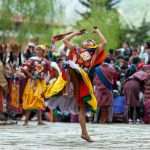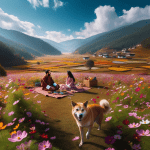Bhutan, the Land of the Thunder Dragon, is a mystical Himalayan kingdom known for its stunning landscapes, rich culture, and spiritual ambiance. Nestled between China and India, Bhutan offers a unique travel experience, blending ancient traditions with a hint of modernity. This blog post delves into the optimal times to visit Bhutan, providing details about the country’s climate, festivals, and activities, which will hopefully ensure a prospective traveller, memorable journey in this serene land.
Overview of Bhutan
Bhutan is a landlocked country in South-Central Asia, renowned for its strong sense of culture and tradition. It is the world’s only Vajrayana Buddhist nation, where the profound teachings of Buddhism remain well preserved and influence all aspects of life. The country is divided into three major geographical regions, each offering distinctive experiences, from exploring ancient Dzongs to trekking in the pristine mountains.
Understanding Bhutan’s Climate
Bhutan’s diverse topography results in a wide range of climatic conditions, from subtropical in the south to alpine in the north. Each season in Bhutan brings its unique charm and set of activities, allowing travelers to witness the vibrant festivals, serene landscapes, and rich cultural heritage of Bhutan at its finest.
Best Time to Visit: Detailed Analysis
Spring (March to May)
Visiting Bhutan in the spring, from March to May, is ideal for those who are keen on trekking and experiencing the country’s vibrant festivals such as Talo Tshechu, Paro Tsechu, and the Rhododendron Festival. However, it is important to note that this is the most expensive time to visit. This season is best recommended for those interested in a mix of outdoor activities and cultural experiences.
Pros: Ideal for trekking and witnessing vibrant festivals.
Cons: Most expensive time to visit.
Festivals: Talo Tshechu, Paro Tsechu, and the Rhododendron Festival.
Recommendation: Best for those interested in outdoor activities and cultural experiences. Read more.
Summer (June to August)
The summer months, from June to August, offer a less crowded experience, allowing for solitude and exploration of Bhutan’s lush green valleys. However, visitors during this time should be prepared for heavy rainfall and foggy conditions, which may not be ideal for everyone but is suitable for those who prefer solitude and lush landscapes.
Pros: Less crowded.
Cons: Heavy rainfall and foggy conditions.
Recommendation: Suitable for those who prefer solitude and exploring lush green valleys.
Autumn (September to November)
Autumn, spanning from September to November, is another ideal time for visiting, especially for those seeking to trek and attend colorful festivals like Thimphu Tshechu under clear skies. However, there can be occasional rains in September. This season is particularly recommended for those desiring pleasant weather and clear, spectacular views of the Himalayas.
Pros: Ideal for trekking and attending colorful festivals with clear skies.
Cons: Occasional rains in September.
Festivals: Thimphu Tshechu.
Recommendation: Best for those seeking pleasant weather and clear views of the Himalayas.
Winter (December to February)
Winter, from December to February, is characterized by clear air and light, with fewer crowds, offering a serene experience for visitors. The cold temperatures and potential snowfall during this season limit trekking opportunities but make it a suitable time for photography enthusiasts and those seeking a peaceful, spiritual experience in the tranquil landscapes of Bhutan.
Pros: Clear air and light, fewer crowds.
Cons: Cold temperatures and limited trekking opportunities.
Recommendation: Suitable for photography enthusiasts and those seeking a peaceful spiritual experience.
Other Considerations
- Visa and Travel Restrictions: Essential information on visa requirements and travel restrictions
- Cost of Visiting: Overview of the daily tariff and additional expenses.
- Cultural Etiquette and Norms: Guidance on the cultural norms and etiquettes to be observed while in Bhutan.
- Health and Safety: Tips and advice on health and safety measures to be taken.
Conclusion
Bhutan, with its rich cultural heritage and breathtaking landscapes, is a must-visit destination. Each season offers a unique perspective of Bhutan, and choosing the right time to visit can significantly enhance the experience. Whether it’s exploring the ancient Dzongs, attending traditional festivals, or trekking through the pristine mountains, Bhutan has something for everyone. Plan well in advance and immerse yourself in the unique charm of Bhutan.


